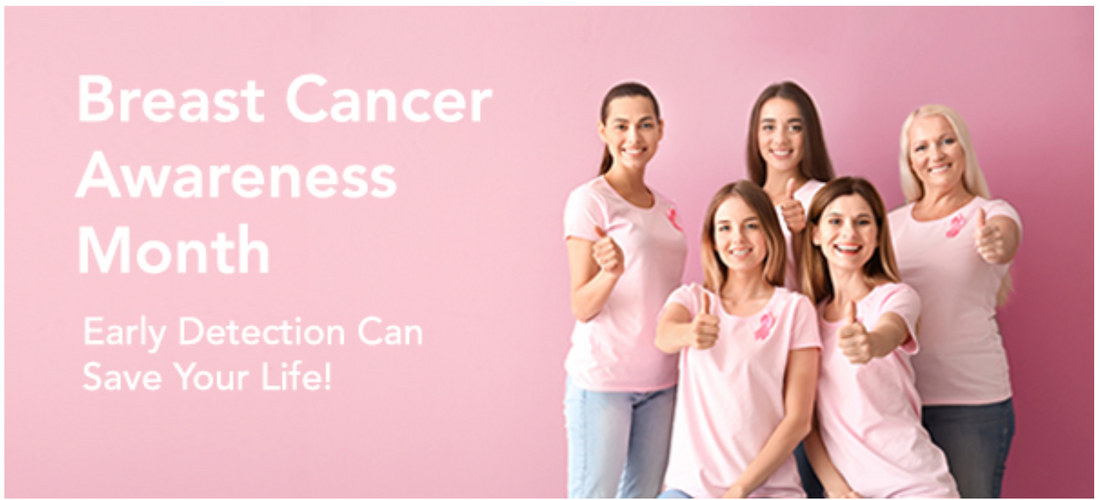
How To Check For Breast Cancer From Home
Our bodies are resilient! They can finish Triathlons, undergo childbirth, climb 100 flights of stairs to rescue disaster survivors. They even manage to beat the unthinkable—cancer. But every cure and battle victory starts with you. Taking charge of your physical and mental health is vital because no one else is going to do it for you.
This is especially true for breast cancer, since most women do not receive a mammogram until the age of 50. Statistics show that around 40% of diagnosed breast cancer cases are first detected during self-exams. Since October is Breast Cancer Awareness Month, we want to share tips and tricks with our Spa Sciences family on how to check your breast from home.
See Visual Of Exam At The Bottom Of This Blog!
Step 1: Look in the mirror
Begin your at-home exam by looking into a mirror. Make sure your shoulders are back and arms are next to your hips. When you are reflecting in the mirror look for unusual size, shape, or color of your breasts. Make sure both of your breasts are evenly shaped without any swelling.
Concerns for a doctor:
- Dimpling, puckering, or bulging of the skin
- Inverted nipple or changed position
-
Redness, soreness, or rash
Step 2: Look for discharge
Continue looking into the mirror but now slowly move your arms above your head. As you are raising your arms, examine your breast for discharge from the nipple(s).
Concerns for a doctor:
If you have any discharge coming from your breast, contact your doctor. This discharge may be milky, watery, yellow, or bloody.
Step 3: Examine laying down
Once you have examined your breasts standing up, lay on your back and start to use your left hand to feel your lest breast—now switch! In order to accurately examine, use a firm, circular touch with the tips of your first few fingers. Keep other fingers flat and together. Continue to do this until you have searched the perimeter of your breast-- from your collarbone to the top of your abdomen, and from your armpit to your cleavage.
According to BreastCancer.org, “follow a pattern to be sure that you cover the whole breast. You can begin at the nipple, moving in larger and larger circles...you can also move your fingers up and down vertically, in rows. This up-and-down approach seems to work best for most women.”
Pro- tip:
When searching your breast, fee for breast tissue from the front to the back of your breast. When you have reached the deep tissue, you should be able to then feel down your ribcage.
Step 4: Go Shower
You might be asking “why,” but according to BreastCancer.org, many women find that the easiest way to feel their breasts is when their skin is wet and slippery, so they like to do this step in the shower.
What happens if you find a lump
It might sound easier than it seems, but it is important to stay calm and grounded. Many women have natural lumps or lumpy areas in their breasts that aren't harmful. These lumps can be due to hormonal changes, an injury or a benign breast condition. If you have a lump, don’t hesitate to call your doctor and ask questions to see what care will be best for you.
If you notice a lump in your breast and decide to watch it for changes before you see a doctor, you should not wait to make an appointment if changes last more than one full menstrual cycle. Call your doctor to be seen if the lumps continue to get bigger or more prominent. If you are menstruating when you find a lump, wait until your cycle is over to make an appointment as changes to your breast during this time are normal.
Call the right doctors
When you find something concerning on your body, you want to make sure you are getting the proper care for it. If you find a lump or have seen long period changes to your breast, call your gynecologist, or primary care doctor. You also can reach out to a nurse practitioner who works with your gynecologist or primary care doctor. This is important in order to receive a proper examination and explanation of the cause of the lump or breast changes. The right doctor will be able to monitor or treat you—it is always okay to receive a second opinion for another doctor.
For more information on breast cancer, or how to get involved in fundraising, please visit www.Spasciences.com/pages/breast-cancer-awarness or www.youngsurvival.org

